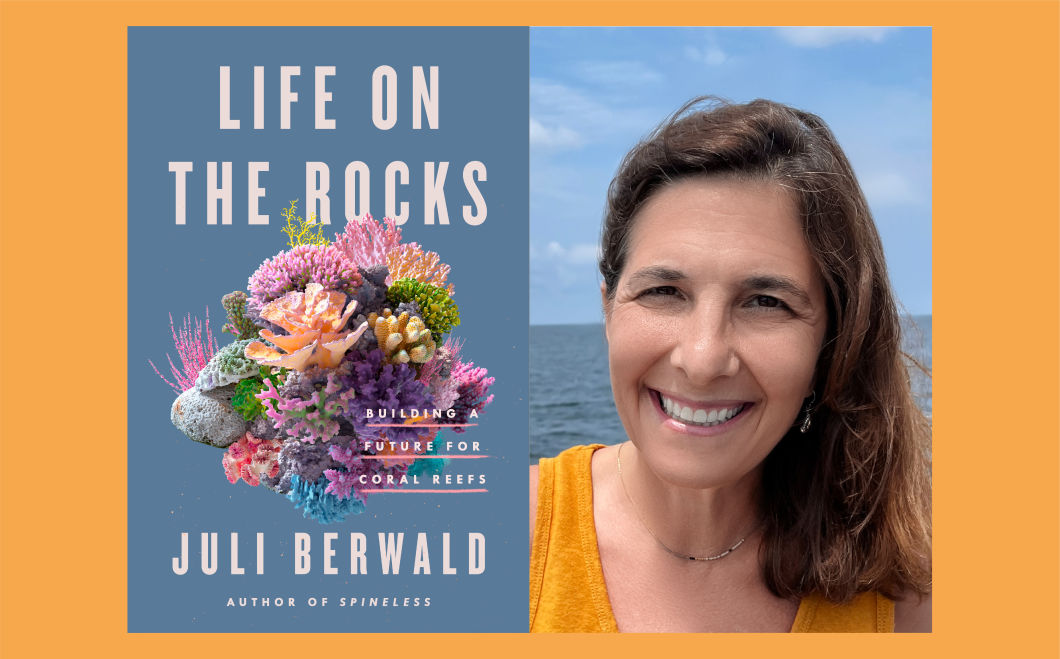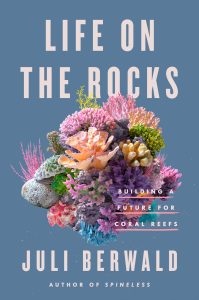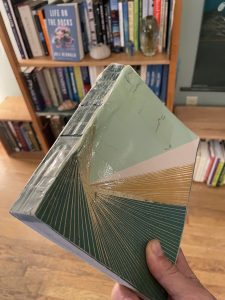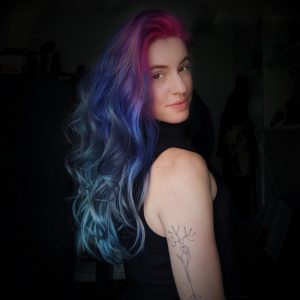
For many of us land-dwellers, coral reefs feel distant, or even invisible. But when ocean scientist-turned-writer Juli Berwald first swam through a coral reef, she writes, “It was love at first sight.” In her new book Life on The Rocks: Building a Future for Coral Reefs, published on April 5, 2022, Berwald paints a heartbreaking yet hesitantly hopeful portrait of reefs worldwide as they are being ravaged by climate change, globalization, and an underwater pandemic. The destruction is spreading faster than scientists can keep up with. But despite the odds, they’re trying anyway.
At least, this is the story Juli Berwald thought she would tell—of scientists’ heroic efforts to rescue corals from extinction. At Reef Futures 2018, a meeting of coral reef scientists, activists, and philanthropists, Berwald was struck by everyone’s infectious optimism in the face of such bleak prospects. She felt inspired to follow along their parallel quests to save the reefs. Their strategies, from in vitro coral fertilization to artificial cloud brightening, were as diverse as the corals themselves. But everyone she met seemed to agree on one thing: If there was anything to be done, they ought to be doing it now, to the greatest extent possible.
As Berwald traveled with scientists to the coasts of Florida, Indonesia, and the Dominican Republic, another invisible sickness surfaced in her own personal life. Isy, Berwald’s eighth-grade daughter, suddenly changed. She began retreating from her loved ones, tortured by rules and obsessions her family couldn’t see. As Berwald wrote about coral reefs, she couldn’t keep her personal story from bleeding into her thoughts, and onto the page. So, she embraced the juxtaposition of personal and scientific, weaving stories about mothering someone struggling with mental illness with conversations about coral genetics.
Just as Berwald was about to leave for one of her final reporting trips for Life on The Rocks, the coronavirus pandemic emerged. She had to cancel her trip to the Great Barrier Reef, preventing her from including arguably the book’s most important character—the world’s largest coral reef system, the site of many reconstruction and conservation efforts. Amid these difficult decisions, Isy’s mental illness worsened, and Berwald’s family made the challenging decision to get Isy help at an inpatient treatment center.* Separating the personal from the scientific became impossible (or, perhaps, doing so was impossible all along).
Berwald talked with Celia Ford about how to introduce personal narrative and vulnerability into science writing. She shared the parallels between her coral reef story and her daughter’s mental health story, and how she wove them together throughout the book. A scientist by training, Berwald knows that scientists are multidimensional people with emotional lives that extend beyond their research. In writing Life on The Rocks, she allows her personal story to complement the science, emphasizing the bittersweet beauty of finding hope in the unknown. (This interview has been edited for length and clarity).
How did your conception of the book change during the writing process, and how much of the story did the pandemic shape?
 When I started the book, I thought I was going to tell the story of the XPRIZE [a non-profit that runs competitions to incentivize “radical breakthroughs for the benefit of humanity”]. I’d follow the top competitors for two years and make that my storyline, and then someone winning the prize would be the end of the book.
When I started the book, I thought I was going to tell the story of the XPRIZE [a non-profit that runs competitions to incentivize “radical breakthroughs for the benefit of humanity”]. I’d follow the top competitors for two years and make that my storyline, and then someone winning the prize would be the end of the book.
But then XPRIZE fell apart, and I felt like my book was falling apart. In following the people I’d picked out, their stories opened up, revealing things I wanted to tell along the way. And then things obviously got quite personal when my daughter got really sick and the world changed.
My daughter got sick right around the time I went to the Reef Futures meeting. I had been keeping a coral journal for this book, and a separate journal of her sickness as we were trying to figure out what was going on with her. It was just my emotional writing about her illness. But when COVID hit and the Australia trip fell apart, my daughter had to go to a residential behavioral health facility. Everything felt like it was coming together, and after a month of being frozen, I just started writing some things.
I wrote to my editor, saying that I was writing stuff I didn’t expect to write, including about my daughter, and that I thought it was some of my best writing. I asked, “What should I do?” And my editor said, “Go with it. Just see what happens.” It was hard to write and it was hard to read, but it was also powerful and emotional, and I wanted to find a way to make it happen. So, I went back and threaded in stories about what was happening to my daughter into earlier chapters of the book. When she did go to the hospital, later in the book, I wanted the reader to know what was happening.
How did you navigate issues of privacy and consent when you were contemplating sharing very vulnerable pieces of your daughter’s personal life? How was she involved in that process?
I told her that I had been writing about our relationship. You’ll notice that all of the episodes are from a mother’s point of view, not hers. I never tried to say what she was feeling or thinking, only what I was thinking and feeling as the mother of someone with a daughter who’s quite ill. I was really careful to not assume anything about what was going on in her thoughts.
She read the whole book and said she was comfortable including the parts featuring her. She has really become an advocate for mental health, going through this. She feels strongly that we need to be talking about mental illness and mental health, and it should not be something to be ashamed of. If she’d gotten diabetes or something, that would have been fine. Why should this be different?
How did you decide where and how to fit your personal story into the broader coral reef restoration story?
I looked to a lot of podcasts for help with that. A podcast like Serial will have moments where the narrator just talks about what they’re having for lunch. There are these breaths in between the main story that I think we, as story receivers, need. And we especially need them during science stories, because they require so much concentration.
I tried to find some episodes from the Isy journal, moments of us sitting together and doing homework, pieces of our life that seemed to blend in with the science I was writing about. For example, there’s this moment where I’m talking about how coral reefs have lived through geologic time and the flooding of the oceans and the planet. I put in a piece where, as my daughter was suffering from OCD, we tried to expose her to something triggering, and that process [is] called flooding—this psychological [technique] where you overwhelm someone with a trigger. I tried to find things that had a vague association with whatever science was going on in that chapter to make it flow.
I think of all my writing like a meal: Science is the protein you really have to eat, but it’s nice to have some carbs on the side. I think about my reader’s experience and try not to overwhelm them with a lot of science, in part by weaving in stories to make it more digestible.
Having the whole thing be the length of a book is nice. In an article, I’m taking out every spare word, because I want it to be crystal clear—there’s no room for extra hair-braiding scenes. But in a book, you have that space.
You mentioned that you were keeping journals. While reading, I couldn’t stop thinking about the fact that you were writing with such beautiful detail about underwater experiences. I imagine taking notes must have been challenging. How were you documenting these aquatic experiences?

Well, I’ll show you my journal: It’s totally waterlogged and taped back together. I guess I’m kind of old school in that way, but it’s easiest. In somewhere like Indonesia, where not everyone has electricity all the time, and a phone could easily fall into the water, a paper notebook made sense.
Sometimes I use voice memos on my phone. At the end of the day, if I’m coming back from a diving day or something, I’ll sometimes speak into my phone and then use a transcription service to convert the voice memo into script, which I can then fix to use as quotes.
I try to write as soon as I can after each trip, maybe even on the way back. If I can go back to my hotel room, I’ll type as much as I can, since I can type faster than I can write on paper. It’s the details that make the reader feel like they’re there, and the whole point of traveling to a place is to bring the reader into that moment.
You talk with experts who have a wide range of ideas about how to best save coral reefs. How did you weigh these differences in scientific opinion while putting the book together?
As with everything in science, there are many different ways to look at every problem, and different parts of the world have different problems. I tried to let the ones that seemed to be the most important to rise to the top.
For example, in the Caribbean, the question of coral reef reproduction is the biggest issue. The Caribbean has lost so many corals already that they’re like evolutionary zombies [coral reefs failing to reproduce, maintain their usual symbiotic partnerships, and otherwise function normally]. There are so many ways to address reproduction: freezing eggs and sperm, in vitro fertilization, letting baby corals grow up until they’re old enough to survive out on the reef, trying to spawn them in a lab, and so on. So I tried to find people who were at the top of the field in each one of those areas.
But at some point, I had to tell myself, “You know what? I’m not writing a textbook on coral restoration. I’m just trying to highlight some of the best examples while also trying to make an emotional plea for us to pay more attention to our oceans.”
Part of it is also just what naturally floats to the top. For example, there are a ton of people studying genetics in coral reefs, but Misha Matz just happened to be down the road from me at UT Austin, and he invited me to hang out in his lab all the time. I talked to a few other people doing coral genetics, but Misha’s work got highlighted because I had such access to him.
How do you know that you have enough information when you’re working on a project like this?

That’s a hard question. You have to get to the point where you believe you have enough. You could sacrifice everything in the pursuit of perfection, but then you’d never publish anything. There’s that balance that you have to strike. It becomes an editorial decision at some point, where you decide, “Okay, I understand this well enough to write about it.”
With a book, you can go a bit slow, you don’t have to rush. But the problem is that new stuff is coming up all the time. For example, there’s been huge progress in coral microbiome research since I wrote that part of the book. Science is always moving, but at some point, you have to draw a line and say, “Hey, this is the end of my book. This is where it is at this moment.”
Besides your editor, who do you seek feedback from throughout the writing process?
I have a writing group who I pass things by, who aren’t scientists. And I passed the science by Misha and some other readers, especially parts that were hard for me to understand. I think you have to convince these readers and yourself that it makes sense.
Towards the end of the book, you wrote something that really struck me. You described hope and grief as being two sides of the same coin, and wrote, “one side will land upward. It is too early to call which side it will be.” In writing about climate change, how did you convey that balance between hope and grief?
Some days are really bad, and some days are fine. In grad school, I worked on satellite imagery of the ocean. My PhD advisor went to Italy for four years during my PhD, and I would go to Italy to work with him every summer. Climate change was real in Italy and the rest of Europe. Then I’d come back to the United States, and it was being questioned. I didn’t have enough savvy back then to understand that the fossil fuel industry was running this big disinformation campaign that was affecting scientists, saying “Wait, do we really have enough information to understand this?”
I think that unhinged feeling never left me. I know that climate change is coming, and that it’s horrible and will change things fundamentally on our planet. Yet I continue to live a life and have kids and own a house and do things. I understand that we need to stomach climate change like that, individually. Part of the fossil fuel companies’ plot was to make it feel like it was our fault.
I think we do live in this world of spinning coins, and the coins haven’t fallen yet. That’s the good part—there’s still some time. One thing that everyone I spoke with felt (maybe because it’s the only thing they could feel) was this sense of not being able to live with themselves if they didn’t do anything. And so, they’re out in the world doing stuff. That was the one thing that everybody said, although I think in their private moments, they all feel like the future of coral reefs is at risk.
One thing about coral, which I bring up a lot, is that there’s a lot of genetic variability, meaning for some of these future questions, we’ll just have to wait and see. I tend to be an optimistic person, and I almost didn’t want to write about coral because I knew there was going to be so much grief. But it’s just my nature: As soon as I start to get hopeless, I’ll think, “But wait! There’s genetic variability!” I’ll find something to bounce off of, to get away from that grief. It’s hard.
We have this ability to kind of turn our backs on the ocean and say, “Oh, we’re up here on land, we don’t have to worry about that.” I think my biggest hope was that the reader would see the reefs as a more visible piece of our planet.
* Correction 5/17/22: An earlier version of this story incorrectly stated that Berwald’s daughter was in an outpatient treatment center. It was an inpatient facility.

Celia Ford is a soon-to-be sixth-year PhD candidate at the University of California, Berkeley’s Helen Wills Neuroscience Institute, where she studies how our brains make sense of the world, and how we update our expectations when the world changes. A TON early-career fellow supported by the Burroughs Wellcome Fund, Celia writes for the Berkeley Science Review and makes podcasts with Carry the One Radio and NeuroCinema. In a past life, she was a drive-time alt-rock DJ at 95.5 WBRU FM. In a parallel universe, she is a pole dance instructor, bass guitarist, and devoted cat parent. You can follow her on Twitter @cogcelia.


